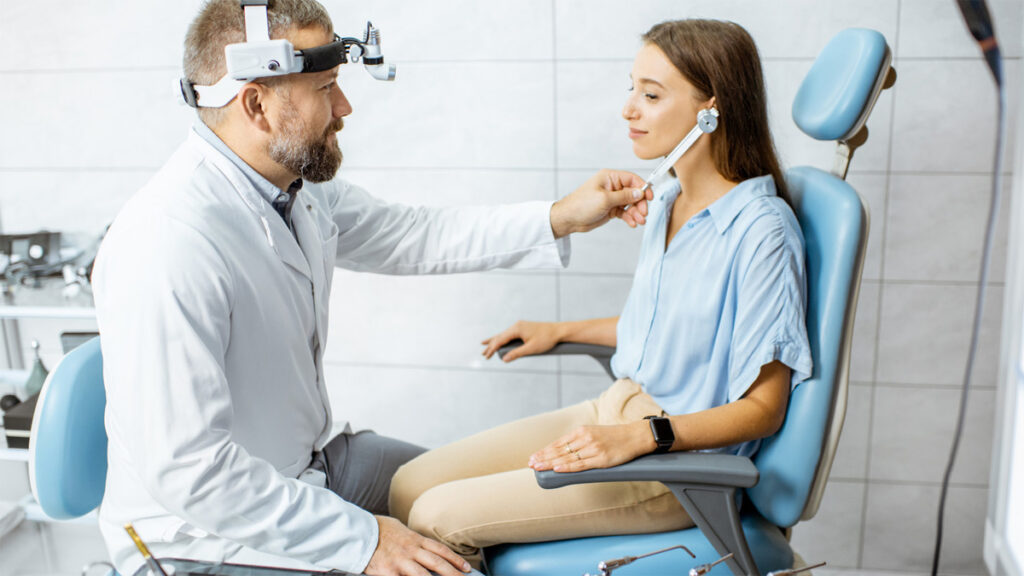Tinnitus occurs when you hear a sound (ringing, buzzing, etc…)) in the ears or head without an external source. It is estimated that over 30% of the US population experiences it. There are two main types of tinnitus: Subjective and Objective. Subjective tinnitus is the most common and occurs when you are the only person who can hear it. Objective tinnitus, which is rare, is when the sound can be heard by the examiner and is typically generated by structures in or near the ear.
Tinnitus can be non-bothersome, meaning a person hears it but it doesn’t bother them or affect their life in any way. For others, tinnitus can affect their ability to fall asleep or stay asleep; it can affect their ability to concentrate, enjoy their social life and can increase their risk of depression or anxiety.
What does tinnitus sound like?
Tinnitus can sound like many different things to different people, there is no ‘wrong’ sound. Most people describe their tinnitus as a “ringing in the ear” but it can also sound like a high-pitched tone, buzzing, crickets, cicadas, hissing, roaring or whooshing. You can also hear more than one sound at a time. It ranges from a low-pitched sound to a high-pitched squeal. It can be soft, loud, or anywhere in between. Tinnitus can be constantly present or intermittently there. It can also pulsate with your heart beat (pulsatile tinnitus).
Many people think the louder the tinnitus, the more bothersome it will become. This is not always true. It actually doesn’t matter how loud the tinnitus is; what matters is how we react to the tinnitus.
Diagnosing Tinnitus
A true tinnitus consultation from an audiologist that SPECALIZES in tinnitus can take anywhere from 90-120 minutes and will contain a number of procedures. You may also be referred for imaging or other specialized tests as well.
Tests and Procedures for evaluating tinnitus may include:
Hearing Health History – Understanding your medical history is important due to the many possible causes of tinnitus. You will be asked about any diseases, medical diagnosis, medications you take, surgeries or hospitalizations you have had in your lifetime. In addition, everyone’s experience with tinnitus is different. The hearing health history will allow you to describe how tinnitus is impacting your life and when it is most bothersome.
Ear Examination – An otoscope will be used to check for obstructions (like earwax) or other forgien bodies that can cause or make tinnitus worse.
Hearing Tests – The ear is made of three parts: the outer ear, middle ear and inner ear. The Hearing Test is actually a battery of tests to assess each part of the ear and look for possible causes of tinnitus.
- Pure-tone testing is what most people are familiar with. You will hear a tone or beep and need to raise your hand (or push a button) when you hear the beep.
- Speech testing requires you to repeat words that you hear.
- Tinnitus pitch and loudness matching allows the examiner to better understand what your tinnitus sounds like to you.
Depending on these results, further testing with Otoacoustic Emissions or Acoustic Reflex Testing/Decay might be needed.
Counseling/Education – this tends to be the largest part of the tinnitus consultation. In this section, you will be educated on how our brain subconsciously reacts to tinnitus, why tinnitus is bothersome for some people but not for all, and what you can do to reduce the impact tinnitus is having on your life.
Treating Tinnitus
Because everyone’s experience with tinnitus is different, there are many ways to treat and/or manage it. Most treatments and strategies include a combination of stress reduction, sound therapy and counseling/education.
Tinnitus Retraining Therapy (TRT) focuses on retraining your brain through counseling/education and sound therapy. The goal is to address why the tinnitus is being heard and to retrain your brain to habituate to that sound. First the tinnitus is reduced and then your reactions to the tinnitus is reduced which allows your brain to treat tinnitus as a non-threatening sound and eventually habituate to it. For more information:https://www.tinnitus-pjj.com/
Cognitive Behavioral Therapy (CBT) is another way to treat tinnitus. CBT looks at how a person reacts to tinnitus. The goal is not to eliminate the tinnitus, but to reduce the negative reactions the person is having. For more information: https://icbt4tinnitus.com/
Progressive Tinnitus Management (PTM) was developed by the Veterans Affairs (VA) and has different levels of treatment. The first level of treatment includes basic education on some strategies on how to manage your reactions. The more intrusive or bothersome the tinnitus, the higher levels of treatment that are needed. These treatments can include relaxation exercises (like deep breathing, imagery, meditation), cognitive behavioral therapy, and the use of sound generators for sound therapy. For more information: https://www.ata.org/progressive-tinnitus-management-program
Hearing Aids can also be helpful when a patient has an untreated hearing loss. Many times when we have a hearing loss that goes untreated, our brain will focus on the tinnitus, making it difficult to enjoy life. When these patients get hearing aids that are properly fit to treat their hearing healthcare, they often report improvement in their tinnitus.
Lifestyle and Home Remedies
There are many strategies you can begin doing in your own home, on your own time, to reduce the impact tinnitus is having on your life.
Stress Reduction – it is widely known that stress is a trigger for most tinnitus patients. If your stress goes up, your tinnitus will probably increase as well. Creating a morning and/or an evening routine that includes activities to calm and relax your mind and body will not only help your tinnitus, but also improve your overall health. Examples include deep breathing exercises, guided meditation, and yoga. These activities do not need to take more than a few minutes a day. Try out a few different activities and find the one that works best for you. Most importantly, make it a habit!
Sound Immersion – When tinnitus first appears, most patients report that it is most bothersome when they are in quiet environments. This is because your brain has nothing else to focus on but your tinnitus. Using sound can be very helpful, especially in the beginning. For example, sounds like listening to the TV or the radio can be used as a distraction. When your brain is attending to a different sound source, it is less likely to focus on your tinnitus. Sound can also be used to lower the perceived loudness of your tinnitus. Think of a candle in a pitch-black room. The flame of the candle will seem very bright in that dark room. When you turn on the lights in the room, the flame doesn’t seem as bright. But did the flame change? No – the environment did. By adding some background sound, your tinnitus won’t seem as loud or bothersome. You can use a box fan, open your windows to hear the birds, or use an app on your smartphone.
Improving Your Overall Health – As with any aliment, a healthy body does better at healing and recovery than an unhealthy one. Focus on increasing the number of vegetables, fruit and whole grains you consume. Slowly begin to reduce the amount of fried and processed foods. There is some research which focuses on “CATS” (Caffeine, Alcohol, Tobacco and Salt) with regard to tinnitus. However, it is unclear if one or all of these are affecting your tinnitus. To know for sure, you would need to choose one of these components at a time and completely remove it from your system for 30 days. If your tinnitus doesn’t change after the 30 days, you can move on to the next one. In general, our recommendations are to increase the amount of good foods (vegetables, fruits, and whole grains) you consume. Talk to a nutritionist on how you can improve your health through what you eat.


